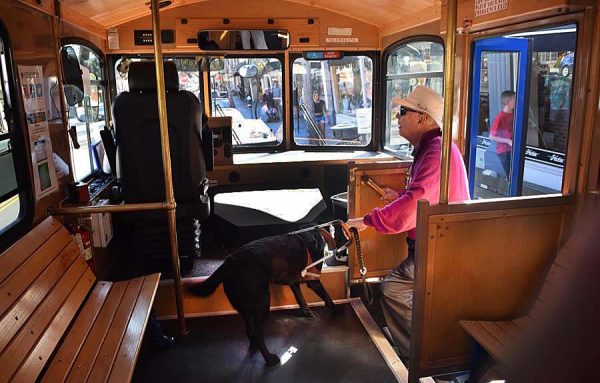
Jerry Lowenter, 84, boards a city trolley with Cassie, his seeing-eye dog, after riding from Top of the World to do business in town. Gary Schwager rides the bus, but finds city signage about routes unclear and confusing. Elaine Nadalin can’t afford a car and live in Laguna Beach.
All three bus riders are worried about how their personal schedules will be upended by the newly adopted route changes in the city’s daily bus and trolley service.
The changes to the city’s transit system approved last month will alter service beginning in June with more changes scheduled for September.
The changes include eliminating neighborhood service in North and South Laguna, including cutting a stop at Mission Hospital’s uphill entry; dropping weekday service in remaining residential areas between 9 a.m. and 2:15 p.m., halting the North Laguna-Laguna Canyon route and reducing the number of trolleys that reach the farthest spot, at the Ritz Carlton. There will only be a stop for Mission Hospital on the Coast Highway route, said Assistant City Manager Shoreh Dupuis. Public outreach about the changes is planned and discussion of a city arrangement for scheduling Uber rides is planned for the May 9 City Council meeting, she said.
Schwager, a board member of the Top of the World Neighborhood Association, said he received 20 calls after the new schedule was approved. Many callers complained they were unaware that the issue was under consideration, he said.
“It does not make sense for a city that says it promotes ‘aging in place’,” said Schwager, a term U.S. Centers for Disease Control and Prevention defines as “the ability to live in one’s own home and community safely, independently, and comfortably, regardless of age, income, or ability level.”
In protesting transit cuts at the March 7 meeting, Schwager laid blame for poor ridership on city officials for confusing route signs and a dysfunctional trolley app.
“I can ask anyone waiting for the bus and there is not one person who knows when the bus is coming because of the outdated signage on the same old benches,” he said.
While city transit officials plan a trial ride-hailing service at a discounted rate to fill in when bus service is suspended midday, Schwager says he does not use Uber and knows many people who lack a smart phone, required to utilize the service.
“It’s a terrific trip on the trolley and I enjoy saying hello to the bus driver,” said Schwager, who wonders why more ideas to boost ridership have not been explored.
For example, he suggested restaurants might offer a discount if patrons showed a stamped trolley ticket. “I’m just pulling ideas out of the air; I’m not a genius,” said Schwager, who maintains that transit officials seemed to focus on cost-cutting rather than boosting the system’s use. “To make a long story short, it’s sad to lose an asset that they need.”
Nadalin, employed as the office manger at St. Mary’s Episcopal Church, borrows or rents a car for the weekend. She cannot afford Uber fares and anticipates that even the 50 percent discount proposed under the city’s arrangement is too much for her budget.
Moreover, Nadalin expresses concern about the impact of transit cuts on the town’s older population for more than one reason. “Cutting access for our seniors runs the risk of isolating the population on a social level. Participation in the community has psychological ramifications. It may be the only key to their independence so they don’t have to bum a ride,” she said.
Nadalin also feels Uber drivers are screened inadequately and seniors are a vulnerable population. “It’s bad news for many, many people, not just our seniors.”
Younger rider Daniell Tradwell, 19, hopped aboard a bus dressed in a bikini and beach towel. She relies on the city trolleys because she doesn’t drive yet. And Pearl Sinclair, 14, who boarded at Thurston Middle School, said, “if I didn’t have the trolley I wouldn’t go places; that’s how people get around.” Her mom allowed Pearl to take an Uber home from a friend’s house just once when she had no other option.
Bus drivers Juan Noyola and Ed Speltie took matters into their own hands when they repeatedly encountered confused riders peering at 2013 schedules at bus stops, including the downtown depot. Both drivers printed out current schedules and hand-affixed them at various trolley stops.
Noyola, a 17-year driver with two years experience in Laguna, said he learned of the proposed transit changes when the council agenda was published. He wondered why drivers were not consulted.
He agrees with Schwager. “We lost ridership because of signage,” Noyola said.
Noyola also expressed surprise that the council discussion omitted mention of compliance with the American Disabilites Act by Uber drivers and that the commercial license required of city-hired drivers includes a medical credential that must be renewed.
North Laguna resident Kim Cole, 62 and a 22-year resident, suffers from medical conditions. She lives off Hillcrest and relies on the trolley to stop across the street in her neighborhood because she is unable to walk downhill to Coast Highway where the service will still be available.
Cole neither drives nor can afford Uber fares. Neither does she trust their drivers. “It’s inhumane to take this away from us,” Cole said.
Lowenter, a 39-year resident, and his guide dog ride the trolley three to four times a week along Park Avenue towards the village. “The city’s gotta do what it has to do, but I won’t be happy.”





[…] until it arrived. The friendly driver gave me a new schedule, but I know service is scheduled to be curtailed after […]